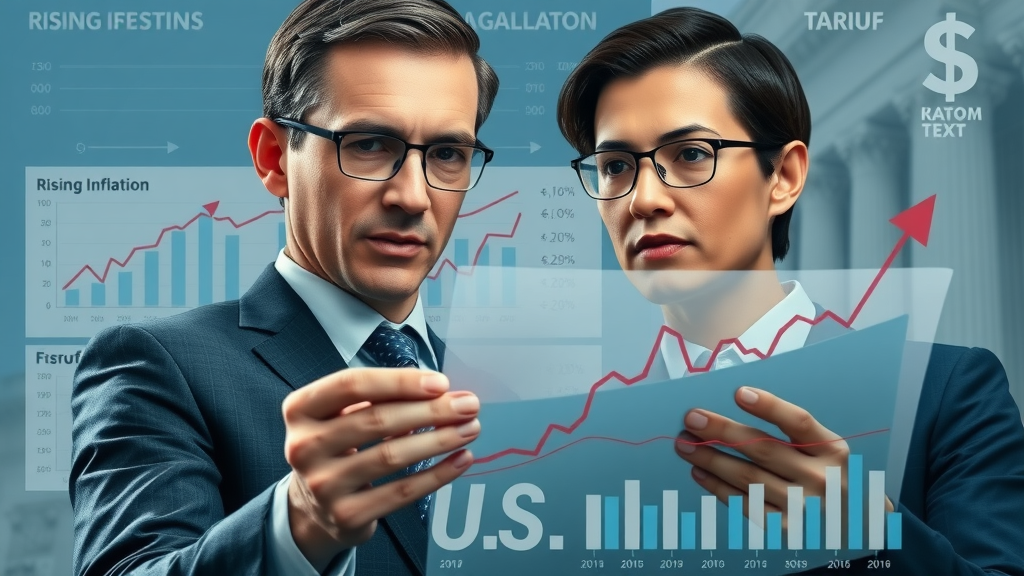Did you know: Since 2018, economists estimate that tariffs have added up to 0.3% to America's annual inflation rate—a burden rarely discussed in everyday policy debates. This hidden cost affects consumer prices, spending power, and even central bank decisions —all beneath the surface of public awareness. If you want to know how tariff rates quietly shape your wallet, the choices of the Federal Reserve, and the United States’ broader economic stability, read on for an in-depth look at the true impact of tariffs on inflation.

Unpacking the Tariffs Impact on Inflation: A Surprising Economic Statistic
The tariffs impact on inflation is a phenomenon that often goes unnoticed by the average consumer, yet it underpins many of the price increases witnessed in everyday goods. Tariffs—essentially taxes imposed on imported goods—were designed to protect domestic industries, but in practice, they frequently pass costs along the supply chain, leading to higher prices for U.S. consumers. For example, when the federal government imposes a higher tariff rate on imported steel or electronics, manufacturers often have no choice but to increase their prices, which then trickle down to consumers shopping for cars, appliances, or tech devices.
In fact, studies of tariff policy in the United States reveal that even a modest 1 percentage point rise in average tariff rates can trigger a comparable increase in the consumer price index (CPI) . Between 2018 and 2024, tariff escalations—particularly those targeting Chinese imports—contributed directly to measurable jumps in the prices of goods and services. This effect isn't limited to one sector: from food and energy to household products, the tariffs impact on inflation is a broad-based challenge affecting personal consumption and overall economic sentiment.
How the Tariffs Impact on Inflation Shapes the United States Economy
The relationship between tariffs and inflation is especially evident when examining shifts in consumer prices following major policy changes. For instance, in response to escalating trade tensions and the imposition of higher tariffs on China, the U.S. saw its consumer price index rise across several categories. It's not just about more expensive imports—U.S. companies reliant on imported materials also experience higher input costs, which are factored into everything from the prices of goods on store shelves to broader measures of personal consumption expenditure . These factors cumulatively increase inflation, pressuring both household budgets and overall economic growth.
When tariff rates rise sharply, the effects ripple out beyond the original targets. Sectors like automotive manufacturing, electronics, and agricultural products—where margins are already slim—feel an outsized impact. The end result? Consumer prices climb, discretionary spending slows, and businesses face tough choices about whether to absorb costs or pass them on. For the Federal Reserve and policymakers, such conditions complicate efforts to strike a balance between supporting domestic industries and safeguarding American consumers from the hidden cost of tariffs on inflation.
For a closer look at how recent policy changes—such as the Trump administration’s tariffs—have specifically influenced inflation and business operations, you can explore the detailed analysis in this breakdown of the Trump tariffs’ impact on inflation and employment goals . This resource offers tactical insights into the real-world effects of trade policy shifts on both prices and the broader economy.
Federal Reserve Perspective: Examining the Tariffs Impact on Inflation
"Since 2018, tariffs have contributed up to 0.3% to the annual inflation rate in the United States, according to leading economists."
The Federal Reserve closely tracks the impact of tariffs on inflation as part of its monetary policy toolkit. During the recent cycle of tariff increases, central bank officials repeatedly cited tariff-induced inflation as a complicating factor in setting the federal funds rate . While 0.3% may sound modest, in a climate where total annual inflation targets hover near 2%, such an increment is both statistically significant and policy relevant.
Fed policymakers face the challenge of controlling inflation while supporting economic growth. Higher tariff rates can push up the consumer price index and cause the Federal Reserve to deliberate more aggressive interest rate hikes. But such actions risk slowing down the broader economy and undermining job growth. Essentially, the Fed walks a tightrope between containing tariff-driven price increases and avoiding excessive tightening that could hamper personal consumption and domestic production.
The Direct Impact of Tariffs on Consumer Price and Spending

Consumer Price Inflation and the Tariffs Impact
Tariffs have a direct and measurable effect on consumer price inflation in the United States. When the government imposes higher tariffs—whether in retaliation or as a protective trade policy—the cost of imported goods like food, electronics, and clothing rises almost immediately. As a result, the price index calculated for these goods moves upwards, which is reflected in inflation statistics reported by agencies like the Bureau of Labor Statistics.
But the impact doesn't stop at the cash register. U.S. manufacturers who rely on parts and materials from abroad must also contend with the higher tariff rates. Their choice: absorb the costs and reduce profit margins, or pass on the increase to consumers and risk losing competitive pricing. The end result is an increase in consumer prices that permeates everything from grocery shopping to big-ticket items, intensifying the overall tariffs impact on inflation .
Consumer Spending Shifts: Understanding the Broader Tariffs Impact on Inflation
As prices rise, American households are forced to adjust their consumer spending habits. With goods and services becoming more expensive, families may cut back on non-essential purchases, delay upgrades on appliances, or turn to lower-cost alternatives. This behavioral shift can be seen in personal consumption expenditure (PCE) data, where a sharp trend toward lower spending growth often follows periods of significant tariff hikes.
In turn, businesses notice shifts in demand and may respond by altering product offerings, shrinking marketing budgets, or scaling back expansion plans. This tighter spending environment dampens economic vitality and reduces the velocity of money circulating through the economy. Thus, the tariffs impact on inflation extends far beyond prices, influencing the overall pulse of the United States’ consumer-driven economy.
Case Study: United States Tariff Rate Increases
Take, for example, the wave of tariffs imposed on Chinese imports between 2018 and 2020. Products ranging from steel to consumer electronics faced double-digit increases in tariff rates . Analysis indicates that these measures added between 0.2 to 0.4 percentage points to annual inflation over the period. As average tariff rates jumped, so did the cost of both intermediate goods and finished products on U.S. shelves. This case underscores the reality that when countries—especially major economies like the United States—adjust their tariff policy, the downstream inflationary effects can reverberate for months or even years.
The data also revealed that industries most reliant on imports recorded the largest price increases, while others experienced indirect effects via altered supply chains or higher costs of domestically sourced substitutes. Ultimately, this case study of tariff rate increases illustrates how trade policy can markedly influence inflation beyond intended sectors.
The Ripple Effect: How Tariff Rate Fluctuations Alter Consumer Prices
| Year | Average Tariff Rate (%) | Annual Consumer Price Index Change (%) | Major Tariff Policy Event |
|---|---|---|---|
| 2015 | 1.7 | 0.1 | N/A |
| 2018 | 2.4 | 2.1 | Tariffs on steel & aluminum |
| 2019 | 3.2 | 1.8 | Expansion: Tariffs on Chinese imports |
| 2020 | 3.1 | 1.2 | Pandemic disrupts trade, rates hold |
| 2022 | 2.9 | 6.3 | Supply chain and tariff overlaps |
| 2024 | 3.0 | 3.1 | Partial tariff reductions, inflation persists |
Tariff rate fluctuations are closely mirrored by shifts in consumer prices . As shown in the table above, periods of aggressive trade policy—marked by higher average tariff rates—tend to coincide with notable upticks in the consumer price index . Although global events (such as the pandemic) contributed to inflationary pressures, it is clear that tariff adjustments play a consistent role in shaping the inflation landscape in the United States.
What stands out is the persistent, almost lagging effect of tariffs on consumer costs, even as average tariff rates are partially rolled back. This underlines a fundamental truth—once prices climb in response to tariffs, they rarely retreat as quickly, leaving a lasting mark on household budgets.

Global Lessons: The Impact of Tariffs Beyond the United States
- Increased manufacturing costs lead to higher consumer prices
- Tariff revenue vs. inflation trade-off: Short-term fiscal gain can quickly be offset by elevated inflationary pressures.
- Domestic industry protection at the expense of consumer spending: Shielding local industries often means everyday Americans pay more out-of-pocket.
The impact of tariffs extends far beyond U.S. borders. In both developed and emerging economies, the imposition of higher tariffs triggers similar patterns: increased production costs, reduced market competitiveness, and higher prices for end consumers. This global experience echoes the lessons learned at home—tariffs may generate short-term gains for specific industries or national treasuries, but the broader impact is a rise in inflation and a reduction in real consumer purchasing power. For example, when European nations imposed steel tariffs during trade disputes, automobile prices across the continent reflected the new reality almost overnight.
This dynamic forces policymakers worldwide to grapple with a familiar conundrum: weighing the benefits of protecting strategic sectors against the risk of fueling inflation and undermining consumer confidence. The global market ultimately reflects a delicate trade-off between domestic industry protection and aggregate economic health—a lesson that continues to shape both U.S. and international tariff debates.
Consumer Price Trends in Key U.S. Industries Due to Tariffs

Within the United States, industries most exposed to trade policy volatility have seen dramatic changes in consumer price trends . For example, steel tariffs pushed up the cost of cars, while tariffs on semiconductors and electronics fueled higher prices for everything from televisions to laptop computers. In some cases, price increases for finished goods surpassed the percentage point rise in average tariff rates , highlighting the way small upstream changes can magnify costs throughout the supply chain.
More subtle yet equally impactful are the secondary effects —domestic competitors, seeing less price competition from imports, may adjust their pricing accordingly, shifting the price equilibrium for entire product categories. Whether the product is produced domestically or imported, the end consumer typically feels the pinch.
International Comparisons: Tariffs Impact on Inflation in Emerging vs. Developed Markets
Emerging economies are especially vulnerable to the tariffs impact on inflation . Many rely heavily on imported food, fuel, and manufactured goods. A modest rise in tariff rates can translate rapidly into price shocks, eroding the purchasing power of consumers and sometimes leading to social unrest. Developed economies, like much of Western Europe, face similar challenges but often have more robust safety nets and diversified supply chains to offset acute price increases.
Regardless of country, the lesson is clear: tariffs are, at their core, a tax on consumers. Policymakers who fail to fully account for these hidden inflationary costs risk destabilizing economies and needlessly burdening households.
"Tariffs are, at their core, a tax on consumers."
Under the Surface: How Tariffs Impact on Inflation Is Often Hidden from Public Debate

Policy Debates: Federal Reserve and Government Stances
Public discussion around tariffs impact on inflation is often overshadowed by political rhetoric or campaign talking points. The Federal Reserve —charged with protecting price stability—frequently points to tariffs as a source of inflationary pressure, yet its warnings compete with confident assertions from the White House and Congress emphasizing the benefits of “fair trade.” This disconnect between central bank pragmatism and government optimism leaves most consumers unaware of the real costs they bear through higher prices at the checkout.
As trade policy shifts and tariff rates fluctuate, it’s vital that these economic realities are clearly communicated. Without an honest dialogue, meaningful solutions to mitigate the tariffs impact on inflation remain elusive.
Who Really Pays? Tariffs Impact on Inflation for the Average Household
Ultimately, the burden of tariff-induced inflation falls squarely on the average American household. Each rise in tariff rates might seem technical, but its effects are anything but abstract. Whether purchasing groceries, fuel, or school supplies, consumers find that their dollar simply doesn’t stretch as far. A closer look at the personal consumption expenditure data shows inflation’s regressive effect—those with less discretionary income suffer the most when consumer prices rise faster than wages.
With policymakers focused on trade wars and macroeconomic strategy, it’s essential to remember: the hidden cost of tariffs is paid at the kitchen table, not the boardroom.
Beyond Economics: Psychological and Social Dimensions of the Tariffs Impact on Inflation
- Perceived Patriotism vs. Actual Economic Hardship
- Behavioral Responses: Changes in Shopping Habits
- Social Narratives: How Tariffs Are Justified Politically

Beneath the policy details, tariffs spark deep emotional and psychological responses. Many Americans view tariffs as an act of patriotism, supporting domestic industries against foreign competition. However, the reality of economic hardship —as evidenced by increased bills and tighter budgets—can quickly temper enthusiasm. For some, the shift in household spending prompts anxiety and resentment, turning economic policy into a source of day-to-day stress.
These psychological effects often manifest in behavioral changes. Consumers may shop less frequently, hunt for bargains, or switch to private-label products as a way to cope with rising costs. From a policy perspective, the ability of governments to shape the narrative—framing trade policy as either national security or economic folly—plays a critical role in whether households accept or resist the inflationary consequences of tariffs.
Tariffs Impact on Inflation and the Federal Reserve's Policy Decisions
Fed Response: Adjusting Interest Rates Amidst Inflation Pressures

The Federal Reserve is not a passive observer in the face of tariffs impact on inflation . When faced with persistent price increases stemming from trade policy shifts, the Fed often responds by adjusting interest rates . This monetary tightening aims to cool demand and anchor inflation expectations. However, raising rates can also slow down economic growth and weaken consumer spending.
Recent cycles of tariff-driven inflation have forced the Fed into a difficult position: balance the need for price stability against the risk of stalling the recovery. The interplay between tariff policy, inflation, and central bank action is a crucial factor in shaping the economic outlook for the United States.
Assessing the Long-Term Impact of Tariffs on United States Economic Stability
The long-term consequences of repeated upward adjustments in tariff rates are hard to ignore. Extended periods of inflation can erode the currency’s purchasing power, reduce the global competitiveness of U.S. industries, and even trigger shifts in exchange rates . Over time, these factors may undermine the economic stability that trade policies were meant to protect.
Thus, as policymakers weigh the costs and benefits of tariffs, it is vital to include their inflationary side effects and downstream economic impact in any comprehensive assessment of national economic health. Without such scrutiny, well-intentioned trade policies risk sowing the seeds of financial instability.
Modern Federal Reserve Strategies: Addressing the Impact of Tariffs and Inflation
"When tariffs increase, the Federal Reserve is forced to walk a monetary tightrope."
Inflation Control Tools: Are They Enough Against Tariff-Driven Price Rises?
The Federal Reserve traditionally relies on monetary policy tools such as interest rate hikes and asset purchases to keep consumer price inflation in check. However, when inflation is driven by external shocks—like a sudden spike in average tariff rates —these tools can prove less effective. In fact, interest rate increases can only do so much to offset cost-push inflation stemming from tariffs.
This reality forces policymakers to innovate. Supply-side solutions—such as targeted subsidies or selective tariff reductions—may be needed to complement standard central bank responses. The future of inflation control likely rests with a combination of aggressive monetary action and nuanced trade policy adjustments.
Predicting the Future: Will Tariffs Continue to Impact Inflation in the United States?
Looking ahead, the question for economists and everyday Americans alike is whether tariffs impact on inflation will remain a persistent challenge. As global supply chains evolve and trade policy debates intensify, the risk of recurrent inflationary surges tied to tariffs is real. However, the U.S. can mitigate this risk through international cooperation, adaptive trade agreements, and ongoing monetary vigilance. The path forward depends on finding a sustainable balance between economic security and consumer well-being.
Policy Alternatives: Mitigating the Impact of Tariffs on Inflation
- Reducing tariff rates on essential imports to lower baseline consumer prices
- Enhancing trade agreements to stabilize consumer prices through global cooperation
- Implementing targeted subsidies for industries most vulnerable to external shocks

For those seeking a dynamic overview, videos now illustrate how tariff rate adjustments alter consumer prices in real time. Visual data shows the journey from trade policy announcement to price tags at your local store, helping Americans grasp the direct link between global decisions and household expenses. Understanding these real-world examples arms consumers and policymakers with the knowledge needed to navigate an ever-shifting economic landscape.

Leading economists often break down the relationship between tariffs impact on inflation , consumer price trends, and how the Federal Reserve responds. Through interviews and explainer sessions, these experts highlight the complexity of trade decisions and debunk myths about who truly bears the costs. Such visual content is invaluable in equipping the public with an honest understanding of what’s at stake as trade policy evolves.
People Also Ask: Do tariffs contribute to inflation?
In most scenarios, tariffs contribute directly to inflation by increasing the cost of imported goods and materials, which manufacturers often pass on to consumers as higher prices. This leads to a broad-based rise in consumer prices.
People Also Ask: How do tariffs affect interest rates?
Tariffs can push inflation higher, prompting central banks like the Federal Reserve to raise interest rates more aggressively to keep inflation in check. Conversely, higher rates may slow economic growth.
People Also Ask: Who benefits from tariffs?
Domestic producers in protected industries may benefit from tariffs, as imported goods become more expensive. However, consumers and industries reliant on imported materials often bear higher costs.
People Also Ask: How does free trade affect inflation?
Free trade generally helps keep inflation low by lowering the cost of goods, increasing market competition, and expanding product choices for consumers.
Your Takeaway: What You'll Gain from This Analysis
- A nuanced understanding of tariffs impact on inflation
- Insights into how the Federal Reserve responds to trade policy shifts
- Real-world implications for consumer prices, spending, and economic policy

Frequently Asked Questions on the Tariffs Impact on Inflation
-
Why does the tariffs impact on inflation differ by country?
The impact varies due to differences in trade dependency, domestic industry structures, and government policy responses. Countries heavily reliant on imports are more sensitive to tariff-induced price increases. -
Can tariffs ever lower inflation?
Occasionally, if tariffs are used strategically during periods of deflation or to correct extreme market imbalances, but typically the immediate impact is an increase in consumer prices. -
What is the historical relationship between tariff rates and inflation in the United States?
Historically, increases in average tariff rates have coincided with upticks in inflation, particularly in sectors most reliant on imported goods and materials. -
How quickly do consumers feel the tariffs impact on inflation?
The effects can be seen within months, especially for goods with short supply chains or frequent turnover, such as groceries and fuel. -
Are there ways consumers can shield themselves?
Consumers can look for domestically produced alternatives, buy in bulk ahead of anticipated increases, or adapt by cutting discretionary expenses, though these measures only partially offset overall inflation.
Key Points Summarized: Understanding the Hidden Cost of Tariffs
- Tariffs typically contribute to rising consumer prices and overall inflation.
- Federal Reserve policy must adapt to trade-related inflationary pressures.
- Economic and political justifications for tariffs rarely account for their broad financial impact.
- Alternative policies could lessen the inflationary effects without sacrificing economic security.
Interested in Sharing Your Perspective on Global Trade and Inflation?
Contact us at 203-271-7991 to contribute your insights and shape the conversation on tariffs impact on inflation.
Action Point: If you have valuable insights on global trade, tariffs, or inflation, reach out today at 203-271-7991 and join the ongoing debate by contributing your article or expert opinion.
If you’re interested in preparing for the real-world effects of upcoming tariff changes, there’s even more to discover about how these policies could influence your cost of living in the near future. For a forward-looking perspective on what to expect as new tariffs roll out and inflationary pressures evolve, explore how tariffs may drive higher prices this summer . This in-depth guide offers actionable strategies and expert forecasts, empowering you to make informed decisions and stay ahead of the next wave of economic shifts.
Recent analyses have highlighted the significant impact of tariffs on inflation and the broader U.S. economy. In an interview with the Financial Times, Michael Froman, president of the Council on Foreign Relations and former U.S. Trade Representative, critiques the increasing reliance on tariffs as a central tool of U.S. economic and foreign policy. Froman argues that President Trump views tariffs not just as trade tools, but as levers for broader political objectives, such as migration control, geopolitical leverage, and domestic manufacturing incentives. However, Froman warns that this tariff-heavy strategy may have significant economic downsides, including increased costs for households—potentially $2,400 annually—and negative impacts on downstream industries. ( ft.com )
Additionally, a report by the San Francisco Federal Reserve examines the effects of tariffs on inflation and production costs. The study estimates that if an across-the-board 25% tariff is fully passed through to finished goods, near-term price increases could be about 9.5% for investment goods and 2.2% for consumption goods. These price increases for investment goods can have important implications for businesses’ investment decisions. ( frbsf.org )
For a comprehensive understanding of how tariffs influence inflation and production costs, these resources provide valuable insights into the economic consequences of trade policies.
 Add Row
Add Row  Add
Add 




Write A Comment